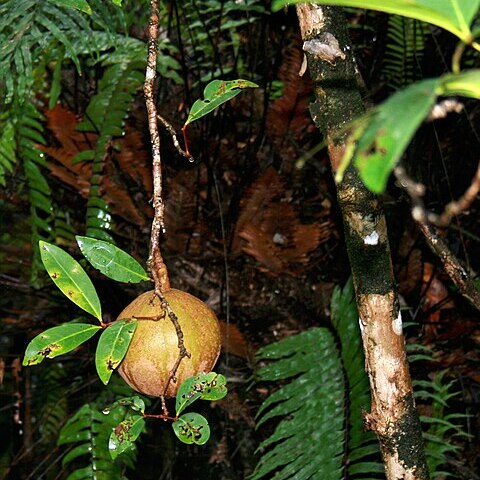Trees or shrubs, semievergreen. Leaves in spirals, even-pinnate; leaflets [2-]4[-8] pairs; leaflet blades with margin entire. Thyrses axillary, consisting of sparse cymes. Flowers appearing bisexual. Calyx short, 4-lobed; lobes oblong, contorted in bud. Staminal tube kettlelike, apically narrowed, apex 8-lobed; anthers 8, sessile, inserted between and alternating with lobes, oblong, included. Disk thick, hemispheric, fleshy, adnate with ovary base. Ovary small, globose, 4-locular, with 3 or 4 superposed ovules per locule; style cylindric; stigma disciform. Capsule globose; pericarp fleshy, dehiscing into 4 segments. Seeds 5-20, large and thick, irregularly tetrahedral to pyramidal; sarcotesta spongy; endosperm absent; cotyledons thick.
Trees. Leaves paripinnate. Flowers unisexual, in short little-branched axillary panicles. Calyx 4-lobed to ± the middle, valvate. Petals 4, contorted, spreading or reflexed. Staminal tube urceolate, similar to that of Khaya. Disk large, red, cushion-shaped, surrounding the base of the ovary and free from the staminal tube. Ovary 4-locular, with 3–6 ovules in each locule; style-head discoid, margin crenellate, upper surface with 4 radiating stigmatic grooves. Fruit a large, pendulous, leathery, subglobose, tardily dehiscent septifragal capsule; columella poorly developed. Seeds 8–20, large, angular, outer surface somewhat rounded, with a corky outer covering.
Semi-evergreen trees of coasts. Leaves paripinnate, usually 2-or 3-jugate; leaflets entire, glabrous. Inflorescence a short axillary thyrse. Calyx 4-lobed to about middle, valvate. Petals 4, contorted. Staminal tube margin 8-lobed; anthers 8, included. Disc cushion-shaped, red, not surrounding or obscuring ovary. Ovary usually 4-locular, each locule with usually 3 or 4 ovules; stylehead discoid. Capsule large, subspherical, pendulous, with 4 tardily dehiscing leathery valves. Seeds 5–20, irregularly tetrahedral or pyramidal, with outermost surface convex, attached to central columella; seed-coat corky, aerenchymatous (? sarcotestal).
Ovary 4-locular, each loculus with 2–4 ovules; style short; style-head discoid, almost completely blocking the entrance to the staminal tube, margin crenellate, upper surface with a minute central papilla with 4 radiating, (?) stigmatic grooves.
Seeds 8–16, large, pyramidal or tetrahedral, with angular margins due to mutual compression, outer side somewhat rounded, attached by the apex to the placenta and so forming a spherical mass; outer integument thick, corky.
Staminal tube urceolate, bearing 8 included anthers inside towards the apex and terminated by 8 appendages alternating with the anthers, appendages subcircular, retuse or shallowly and irregularly 2 (3)-lobed.
Fruit a large almost spherical leathery septifragal capsule, dehiscing by 4 valves; septa thin, ultimately breaking down.
Disk large, red, cushion-shaped, situated beneath or engulfing and fused to the ovary, free from the staminal tube.
Trees of mangrove swamps and coastal scrub, often with pneumatophores or ribbon-like buttresses.
Calyx lobed to or beyond the middle, lobes 4, aestivation open.
Petals 4, free, much longer than the calyx in bud, contorted.
Flowers probably monoecious, borne in compound cymes.
Leaves paripinnate, leaflets entire.

